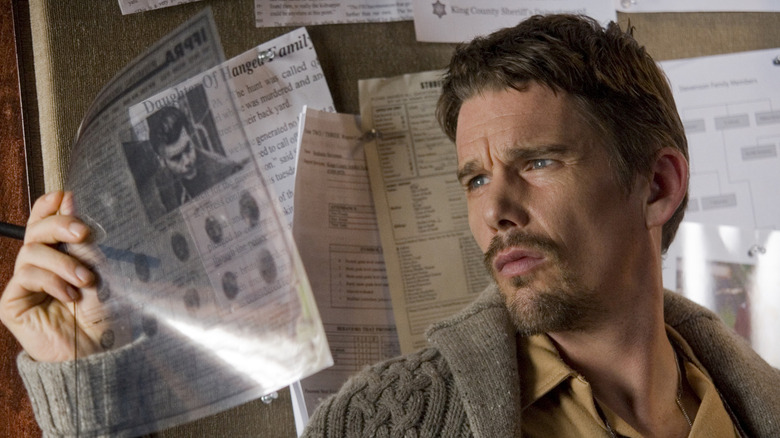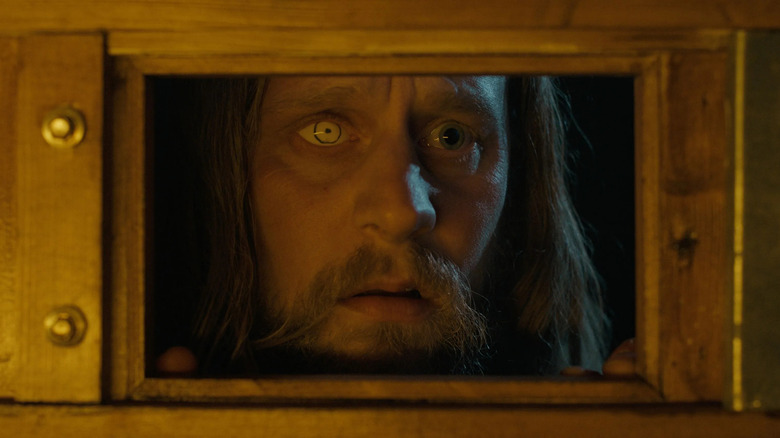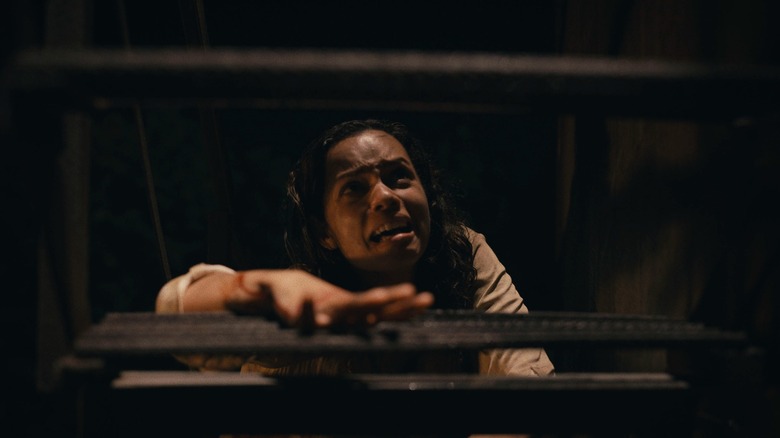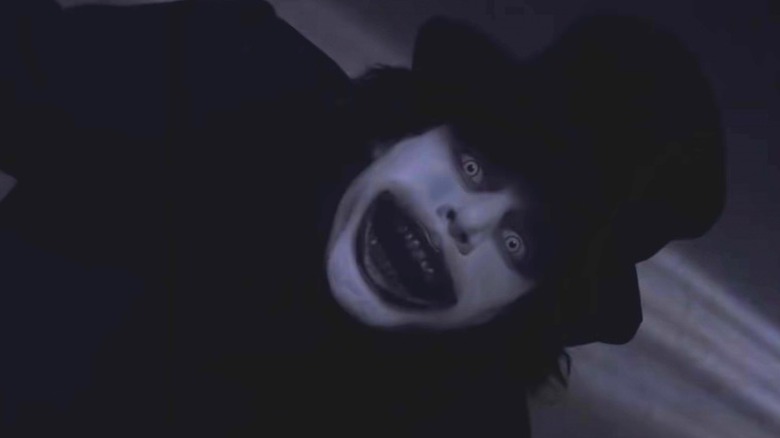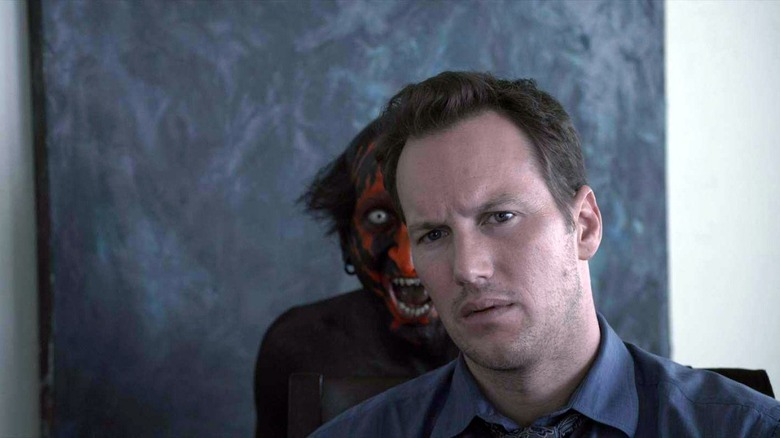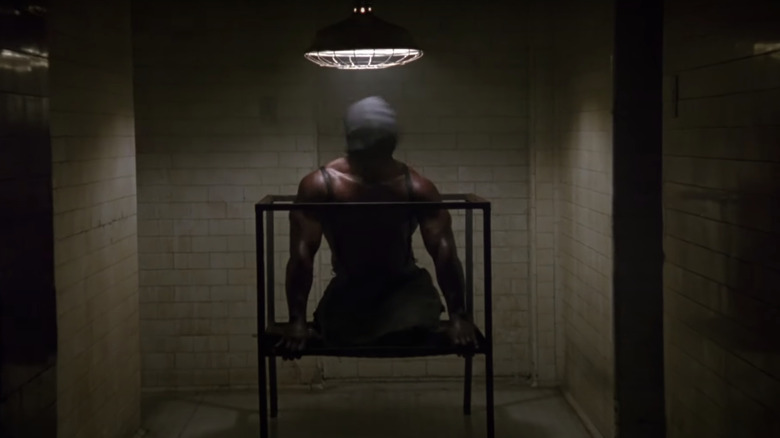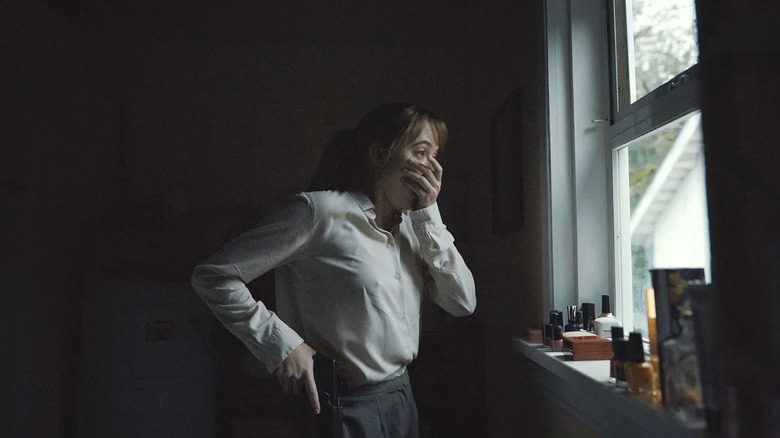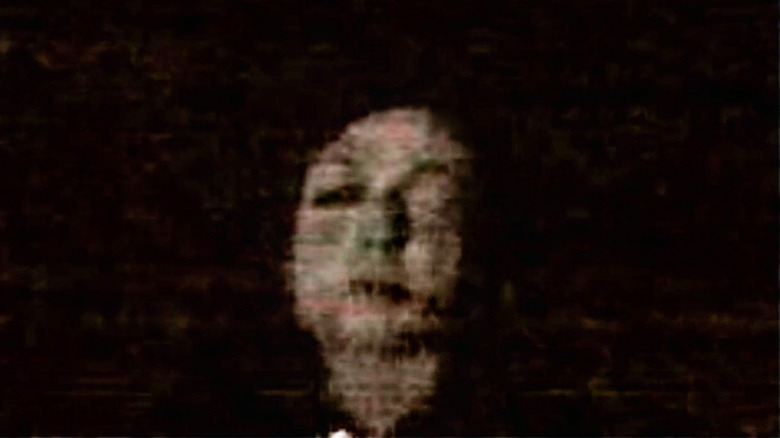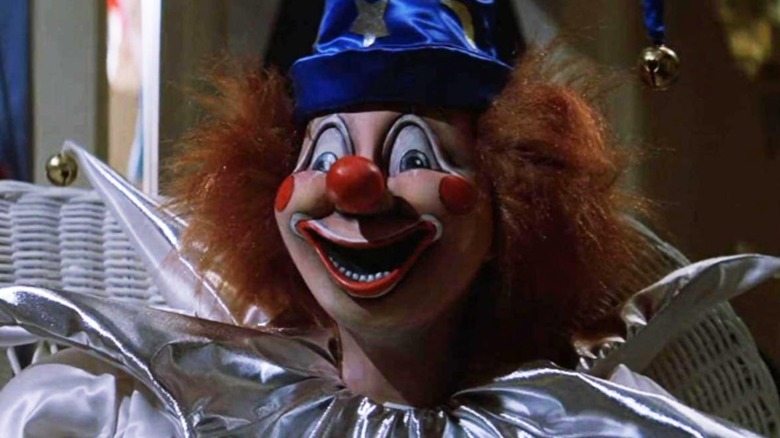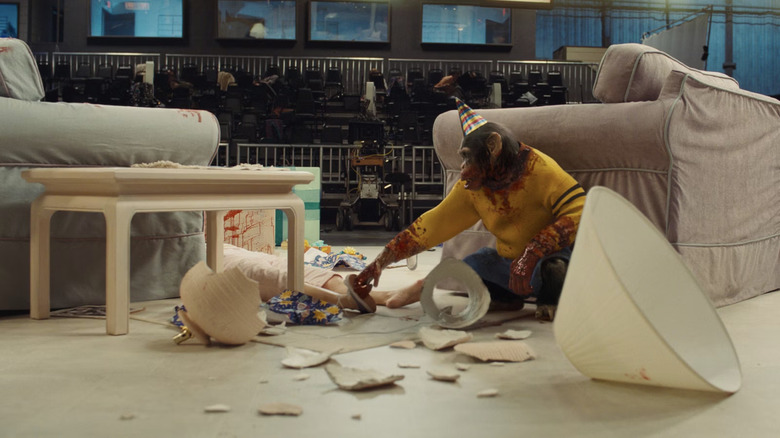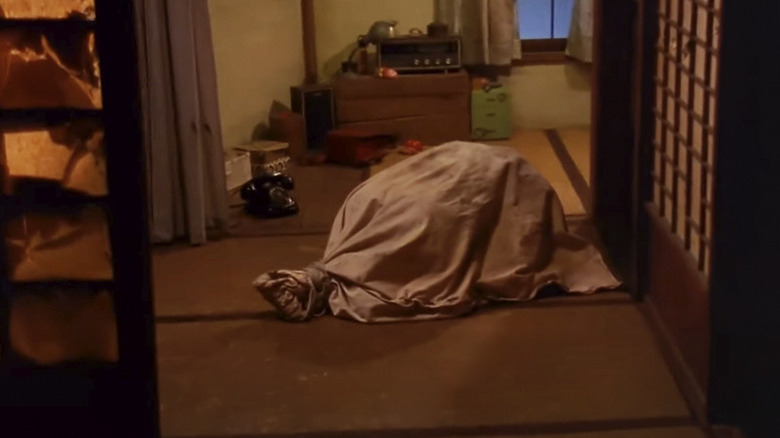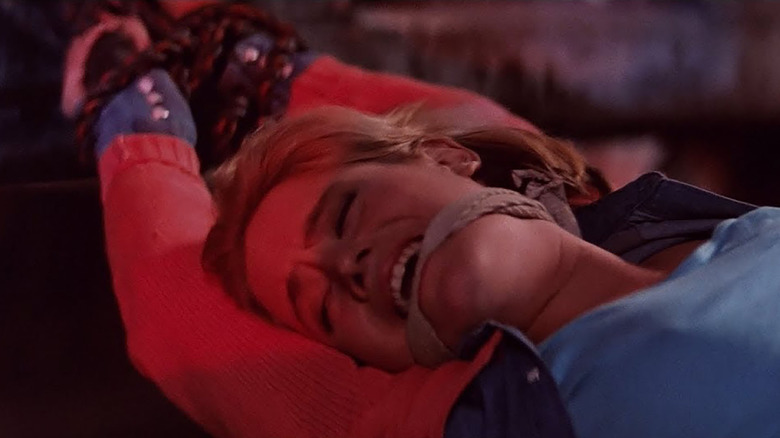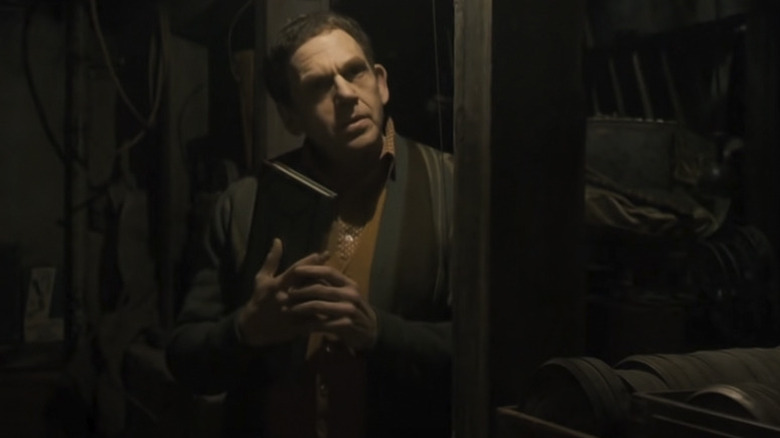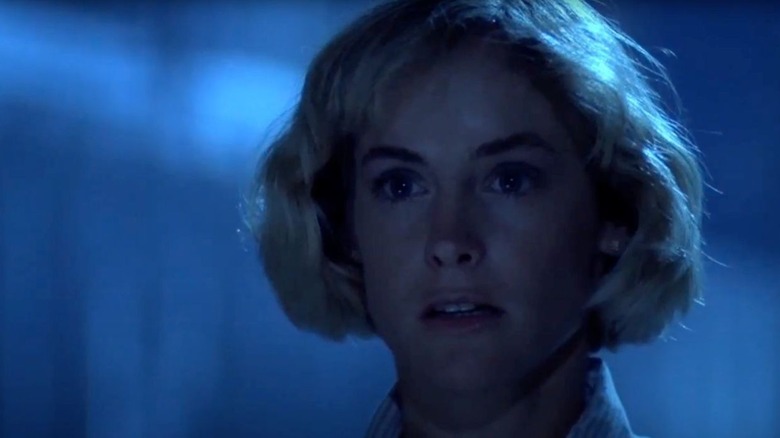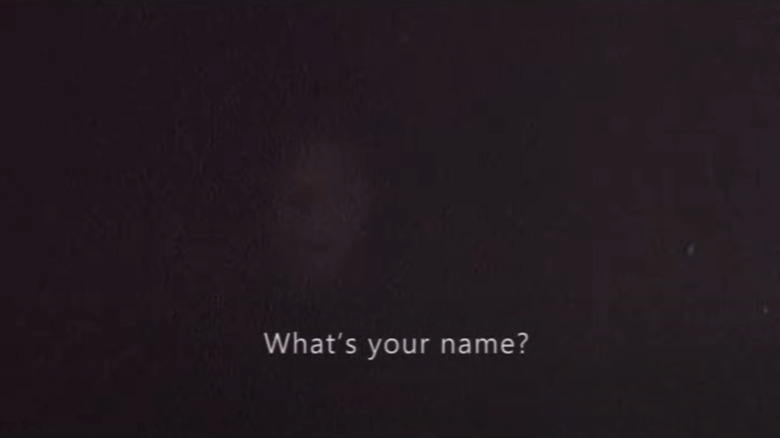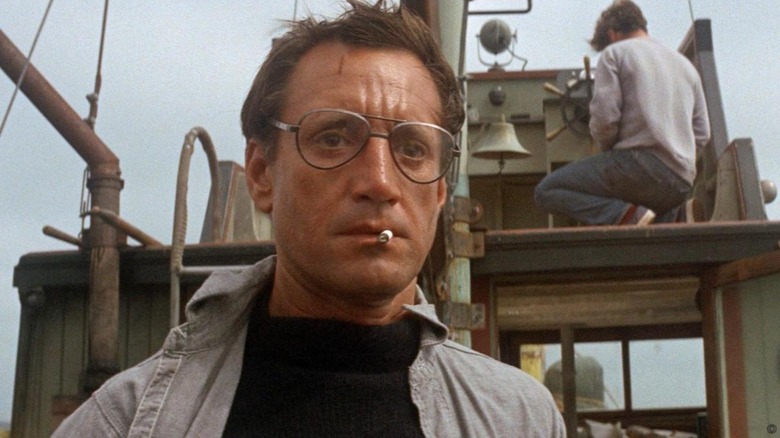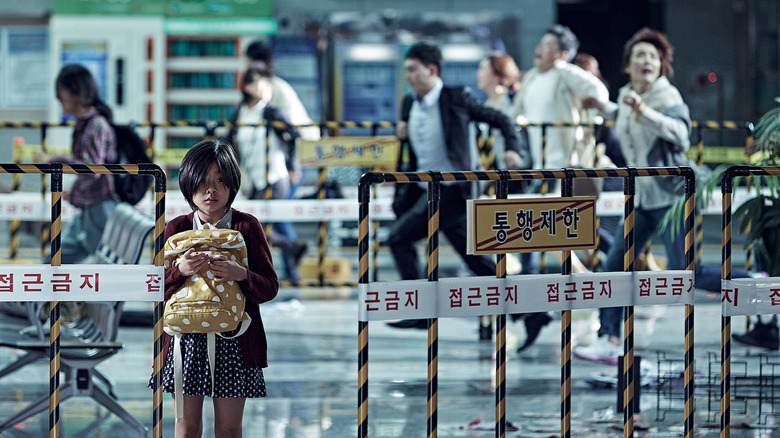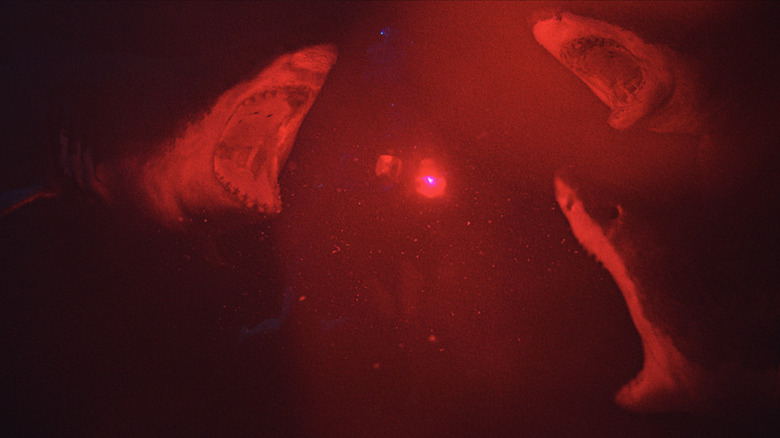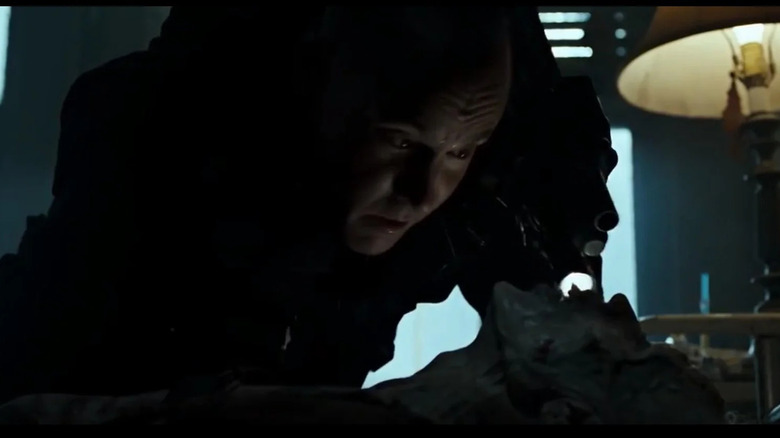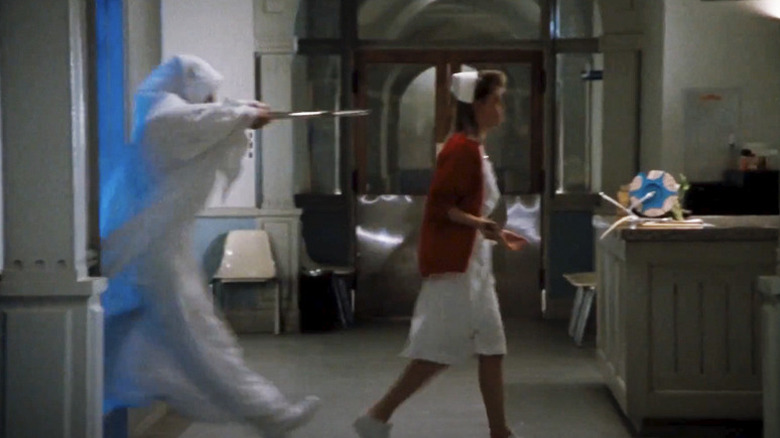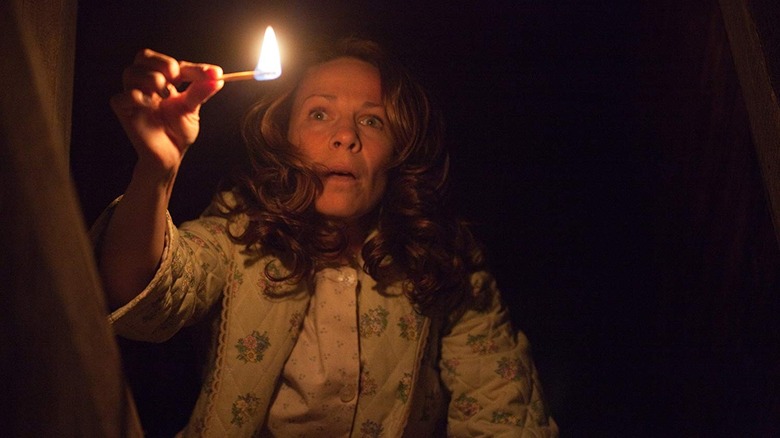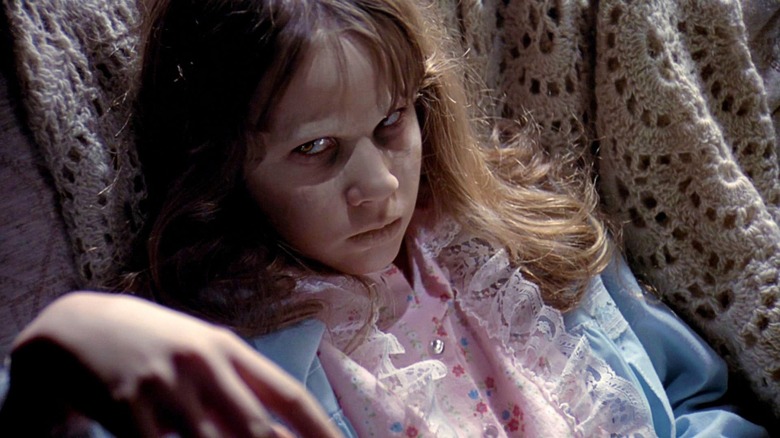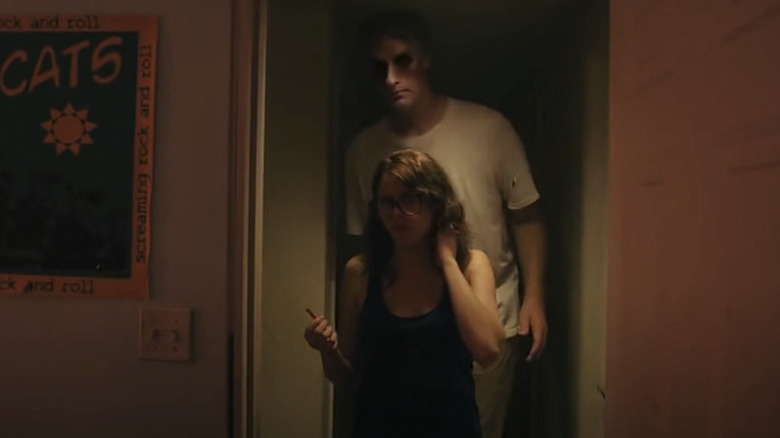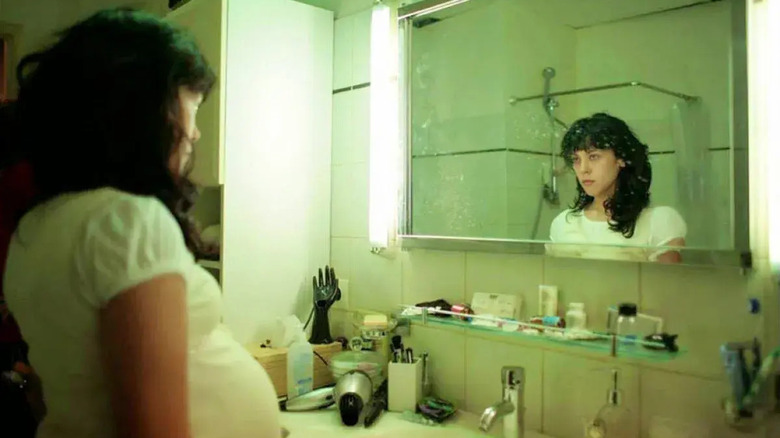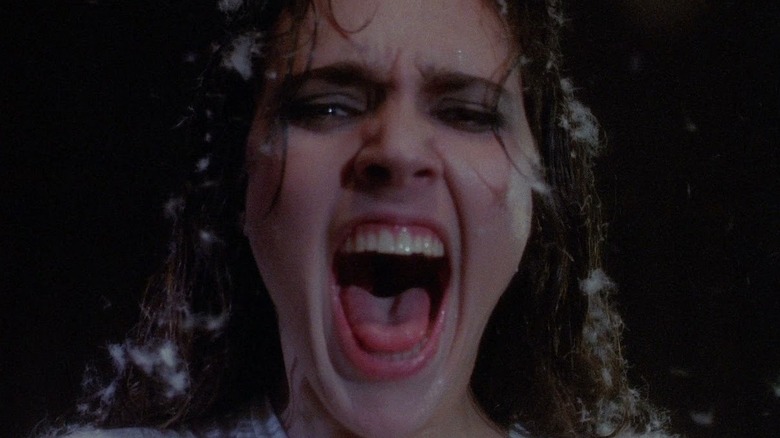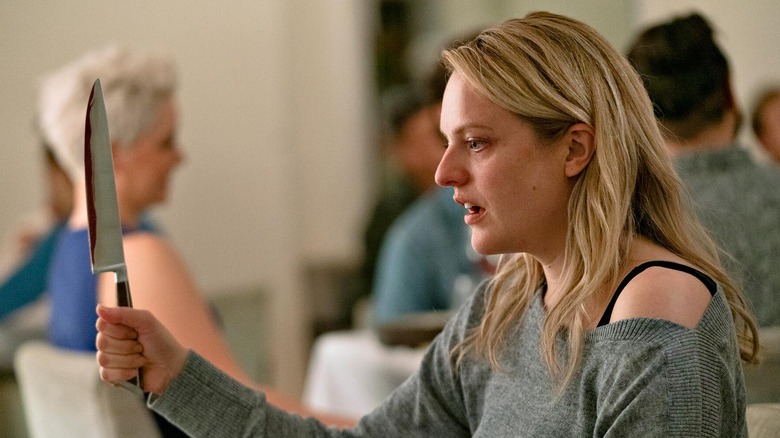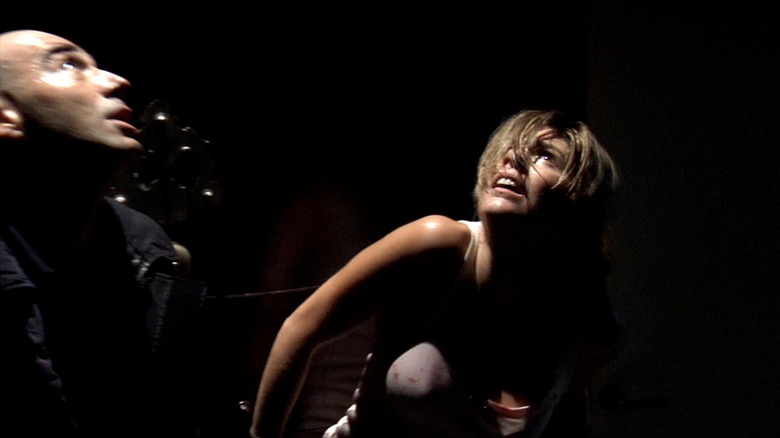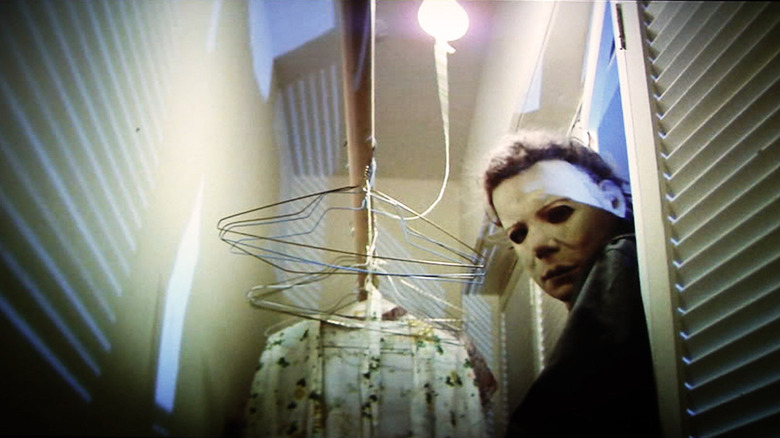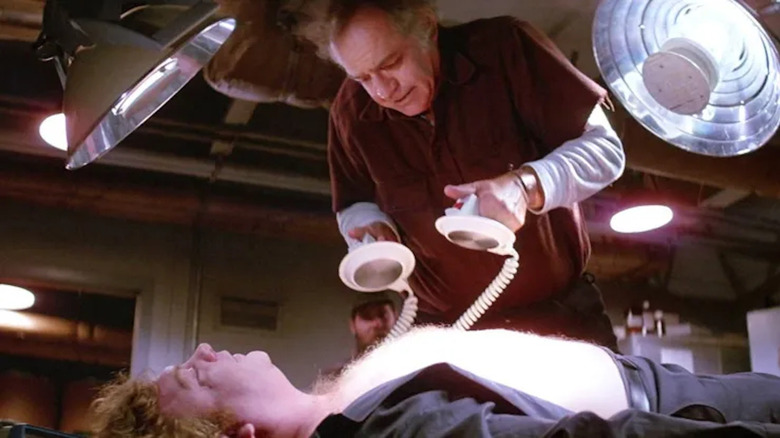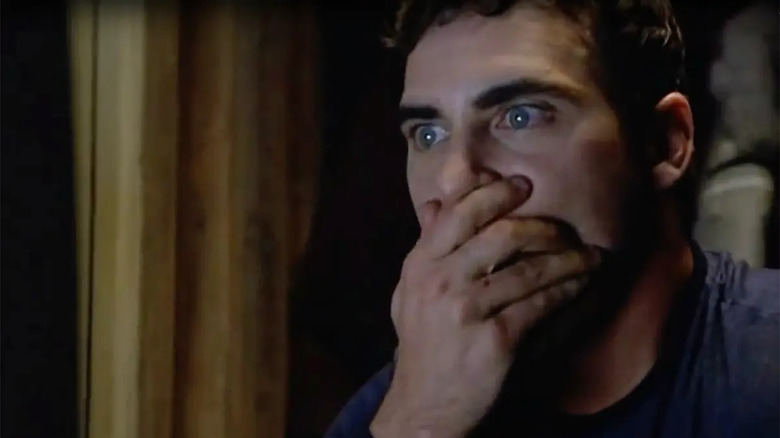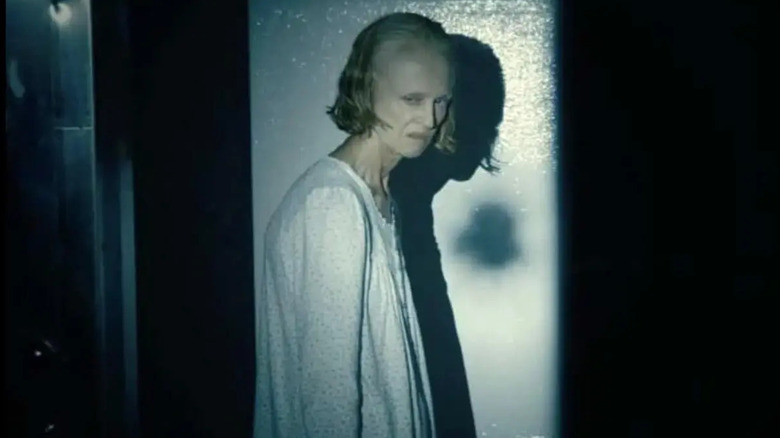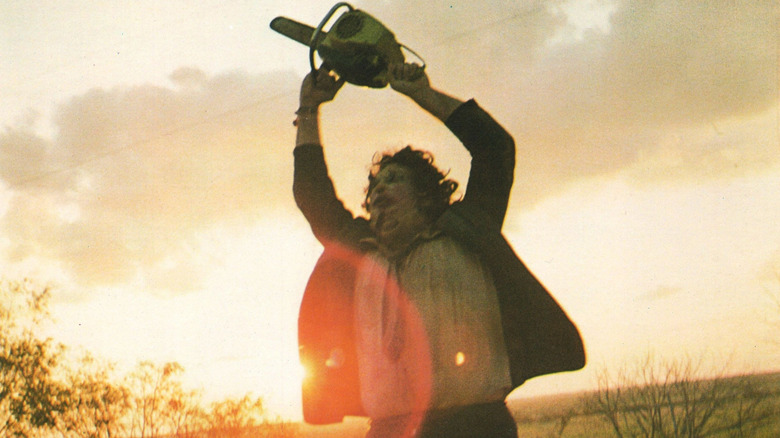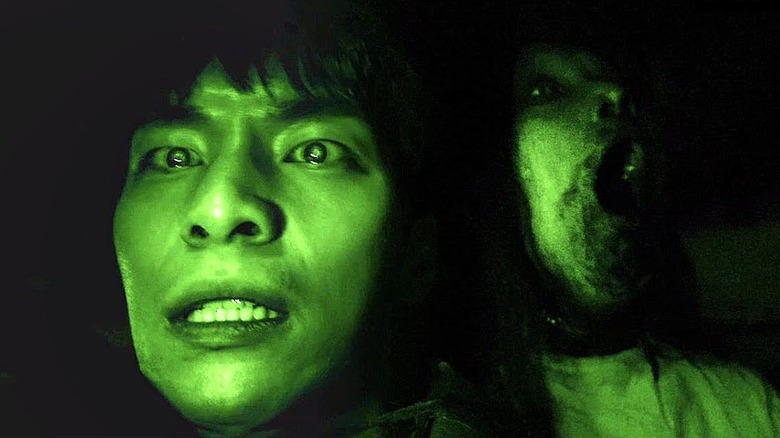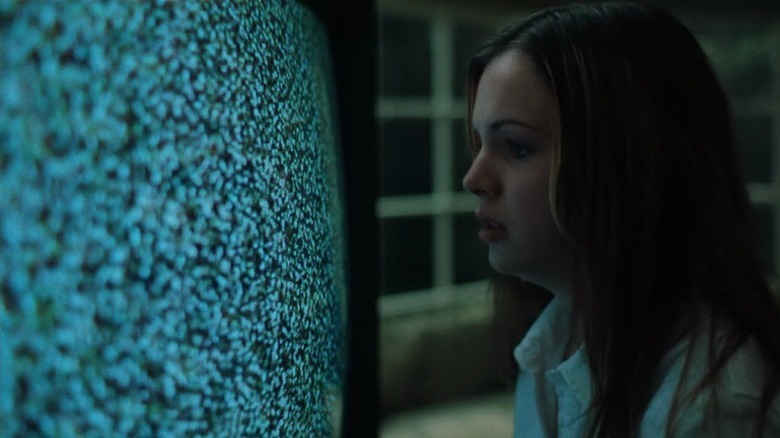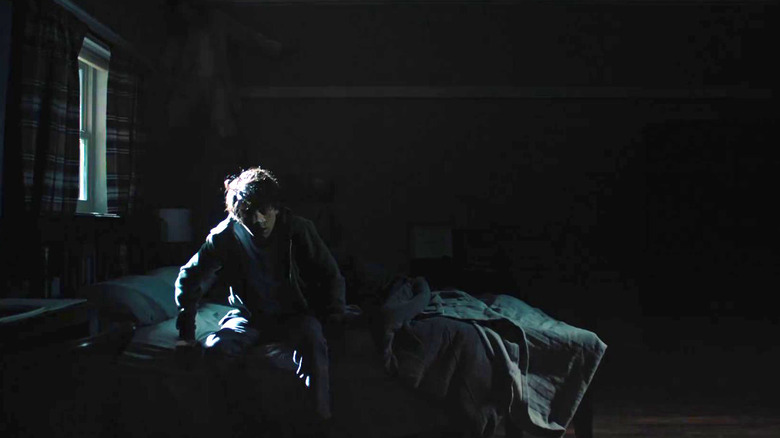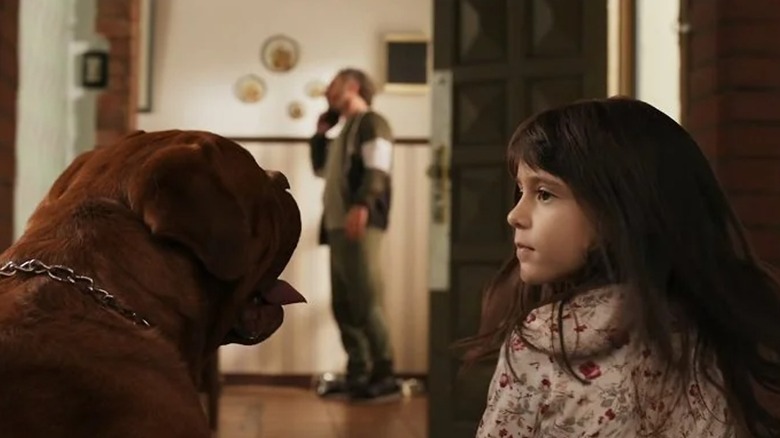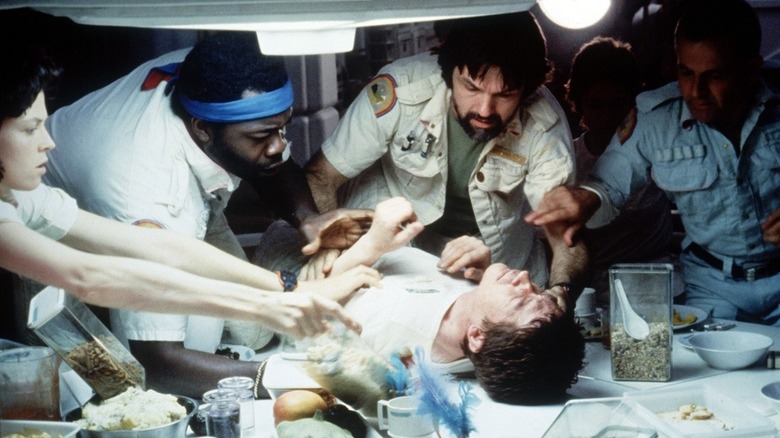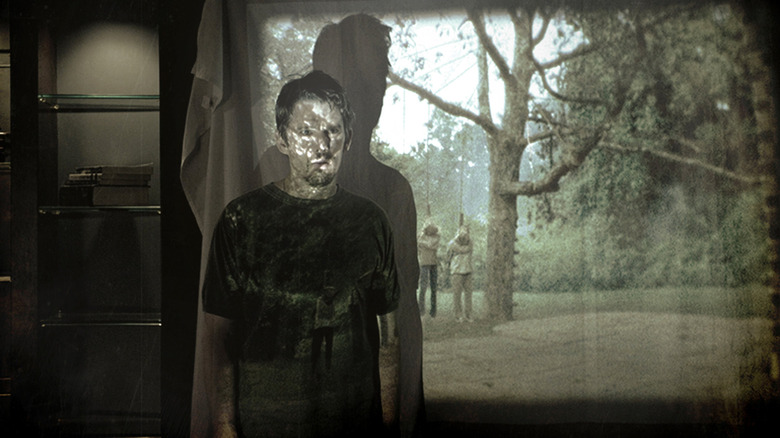The 37 Scariest Movie Scenes Ever
Everyone loves a good scare, and there are plenty of them — a century of horror movies has seen to that. If there's something out there that unsettles you, makes your skin crawl, or convinces you to sleep with the lights on, there's almost certainly a film that taps into it. There's no shortage of good horror movies or scares. But what about the great ones? What about the greatest ones?
As the days grow shorter and the nights grow cooler, we decided to tackle that question directly. /Film assembled its horror brain trust to compile a list of the scariest movie scenes ever, a tribute to the cinematic moments that have left us truly rattled. Over a series of conversations and several rounds of voting, we emerged with a list of the 31 moments that still manage to rattle our jaded selves to the core.
A note before we proceed: the /Film staff had several big conversations about what defines a "scary" scene for the purposes of this list, and we decided on one major rule. For this ranking, we would only consider scenes we found actually terrifying rather than scenes that were just famous. There are countless incredible horror movies with iconic scenes and sequences that we love and treasure that you will not find on this list. It hurt us to cut the shower scene from "Psycho," the low-key chills of "Rosemary's Baby," and anything from the classic Universal Monster movies. They're all masterpieces, yes, and they contain some of the greatest moments in horror cinema. But are they the scariest scenes ever? We made the tough choice to dust off the canon and retire some of the classics for our purposes here. What actually scares us, seasoned horror fans, right now? And that's what drove the list.
So let's dive in. These are the scariest movie scenes ever.
37. The Tent Scene in Oddity
"Oddity" is the kind of movie that feels like it is destined for cult status. It got a muted theatrical release and, inevitably, people are going to slowly discover it on streaming and it will be talked about in that, "Holy crap, have you seen this one?" way amongst horror fans for years to come. There's good reason for that. /Film's Chris Evangelista called it a "good old-fashioned scary movie" in his review. While the film has plenty of scary moments, the tent scene is the cream of the crop here as a true masterclass in crap your pants filmmaking.
For those who haven't seen it, the film centers on a blind woman named Darcy whose sister is murdered. An escaped mental patient under the care of her sister's husband was the prime suspect. Darcy is a self-proclaimed psychic and collector of cursed items, and pays an unexpected visit to Ted and his new girlfriend. Convinced that there was more to her sister's murder than people know, Darcy brings some dangerous items with her to uncover the truth.
The scene in question comes relatively early and focuses on Darcy's poor sister. It's a brilliant bit of misdirection in every way. At the time, she and her husband are new to their big, empty country home. There's a mysterious stranger knockin' on the door. There's a tent in the front room. There are almost no lights. There is, however, a camera to capture the horrifying truth that this creepy stranger tried to warn this poor woman about. There's a stranger in her home, and their intentions are not good.
It's the sort of scene that has so much build up dread that the viewer knows something bad is coming. It's not some cheap, out-of-nowhere jump scare or just a loud noise. The big moment is so impactful and so straight-up scary that it sets the tone for the rest of the film. The viewer is on edge from that point on. Director Damian McCarthy executed a masterclass with this one.
36. There's Something in the Tunnel in Barbarian
Zach Cregger's "Barbarian" opens with a rented house double-booking that feels like the start of a taut psychological thriller, where Tess (Georgina Campbell) needs to make the best out of the uneasy situation of sharing a rental with a stranger, Keith (Bill Skarsgård). The tension between the two is a subtle mix of sweet and ominous, with Skarsgård perfectly balancing harmless chivalry and veiled intentions that might or might not be sinister. After Tess discovers the hidden underground tunnel that spooks her out, we witness what seems to be a classic trope in horror: a man with unsavory intentions crying out for help to lure the unwitting victim to an unsafe space. When Tess ventures inside the tunnel once again, phone in hand to light the way, we are meant to brace for the inevitable reveal of Keith being a killer, or worse.
However, "Barbarian" knocks the wind out of our lungs by springing an unexpected scare in all its violent, bloody glory. Just when we expect an injured Keith — who frantically urges Tess to venture deeper — to reveal his true colors, something grabs him by the head and violently bashes his skull against the wall. While the tragic, terrifying origins of The Mother are revealed later, her sudden appearance in this sequence is the stuff of nightmares, as it is a threat we are absolutely not prepared for. Tess' screams and the abrupt cut to a shift in scenery feel effectively jarring, as it feeds into the suspicion that Tess, just like Keith, is doomed to meet a swift death. Symbolic connections to the "madwoman in the attic" trope — quickly referenced with a copy of "Jane Eyre" — flesh out the unnamed entity in the tunnel that is waiting to be discovered in this house of horrors.
35. Something's in the Shadows in The Babadook
"The Babadook" is one of the most emotionally rich and thematically compelling horror movies in recent memory. It's also scary as heck. Director Jennifer Kent uses the titular monster as a stand-in for grief, trauma, and mental illness, proving once again that our greatest monsters are always metaphors.
It helps that, you know, the Babadook is really good at appearing suddenly without warning. In the film's scariest scene, widowed mother Amelia is trying to sleep, but there's a noise coming from a particularly dark corner of her bedroom.
She investigates — it's just the dog. Mystery solved.
But the noise persists.
Paralyzed with fear, she watches as ... something .. moves in the shadows. We catch quick glimpses of limbs and shapes. We hear its croaking voice. And then it's on the ceiling, crawling unnaturally, like a stop-motion creature birthed from our darkest subconscious. We don't even have time to take this in, to understand it when the Babadook lunges at Amelia. It's proof that jump scares are only lazy when they come out of nowhere. The best of them serves as the natural climax to masterfully built tension and dread.
34. A Demonic Face Appears in Insidious
What's it say about a filmmaker's talent and a horror film's overall potency when a memorable trailer scare becomes a defining ghoulish image in the genre's recent history?
James Wan's "Insidious" is his first franchise (smh "Dead Silence" stayed silent), placing Patrick Wilson and Rose Byrne in a household under siege by demonic villains. Josh (Wilson) and Renai (Byrne) Lambert's children become targets for a resident of The Further dubbed "Man With Fire On His Face," an evil entity who some might presume is cosplaying Darth Maul at a quick glance.
For a now-infamous scare, Lorraine Lambert (Barbara Hershey) describes a dream about the red-faced demon as both Josh and Renai intently listen. As she concludes, stressing the nightmare's implications, the mentioned devil-demon appears behind Josh and hiss-scowls at Lorraine, who then doubles back in fear.
A straightforward blueprint yelp, expertly defined by Wan's camerawork as the frame focuses on one person at a time — cuts are frantic, back and forth, unassuming until the edit to Josh reveals an underworld infiltrator interrupting the otherwise quiet scene of dialogue.
33. The Hospital in Jacob's Ladder
If you're a fan of the "Silent Hill" video games, you can thank "Jacob's Ladder" for all of the nightmarish imagery.
In this 1990 psychological horror film from Adrian Lyne, Tim Robbins plays a Vietnam veteran named Jacob Singer who is plagued by fragmentary visions, disassociation, and grotesque hallucinations. Singer struggles to tell the difference between reality and delusion, with the images surrounding him switching on a dime.
The entire film is a grisly assault on the senses, but Jacob's journey through a hospital is absolutely unforgettable.
After traveling through a plastic curtain, the floor of the hospital is suddenly covered in blood, guts, and severed body parts. Hospital patients look down from the ceiling while contorting their bodies, organs get caught under the wheels of the hospital gurney, and a new horror awaits wherever Jacob looks. In the most memorable moment, Jacob looks to see a man with amputated legs trapped on a fenced table with a black sack over his head. The man's head shakes manically, at a speed impossible for humans to achieve.
This effect would be reused in future horror movies and nu-metal music videos, but the initial use in "Jacob's Ladder" was so shocking, it became the namesake for the style of filmmaking required to achieve the scare.
32. Lee Finds Her Doll in Longlegs
"Longlegs" rode a masterful marketing campaign to success and acclaim as one of 2024's best horror films. The film is unnerving from frame one and as it goes on, chills crawl up your spine, sensing that you're about to discover something awful onscreen. Director Osgood Perkins plays his hand like a master in the third act, transitioning from a procedural into full-blown supernatural horror — you buy this leap because even if you hadn't noticed the Devil watching in the background, the movie's atmosphere screams that there's an inhuman evil at work.
The exact moment "Longlegs" makes this jump is when FBI Agent Lee Harker (Maika Monroe) — having just watched the killer (Nicolas Cage) end his own gruesome life — investigates her childhood home to find her mother Ruth (Alicia Witt). Perkins moves his camera with Lee, making us stay on our tiptoes with her as she moves through the house, expecting something horrible. The danger is actually outside, where Ruth shotgun Lee's fellow agent then lures her daughter to a field with a doll — a doll modeled on Lee's childhood self. You see, Longlegs wasn't just a mudane Satanist killer. He stored his master's evil inside these dolls, which Ruth gifted to families marked for death. The doll she destroys is the one Longlegs meant for Lee, until Ruth bought her daughter's life with complicity.
The explanation is belabored with a flashback montage, but that's offset by how scary the facts being revealed are. Some have criticized "Longlegs" for an underwritten script, one that doesn't have any themes or message beneath the dread. If there's one idea you can pick up from the film, though, it's that parents will go to some terrifying lengths to protect their children.
31. The Cell Phone Footage in Lake Mungo
Never before has grainy cell phone footage been so deeply disturbing.
In Joel Anderson's 2008 horror film "Lake Mungo," starring Talia Zucker, a teen girl drowns while vacationing with her family at a dam. Ever since, her parents and brother struggle to come to terms with her death and begin to suspect her presence in the house, thanks to video footage set up by her brother. After digging and learning shocking secrets about Alice's personal life prior to her drowning, they travel to a spot where she was seen burying something in one of their old videos. What she buried was a cell phone, and the footage on it haunts millennials to this day.
The footage shows her walking along the shores of Lake Mungo and running into a waterlogged, corpse-like doppelgänger of herself, looking like her body was freshly pulled from the lake. It's visible for mere seconds, but that little white face is like looking at death itself, an image so chilling that people still talk about this little Aussie indie horror over a decade later.
30. The Clown Doll in Poltergeist
You know that clichéd scene in horror movies where a character hears a scary noise and inexplicably thinks it would be a good idea to just hang their head over the edge of the bed and look underneath it? Well, one of the reasons it became a cliché is because generations of horror directors were scarred by the infamous clown scene from "Poltergeist."
Robbie (Oliver Robins) is understandably creeped out by a clown doll in his room, and things only get scarier when he looks up to find that the clown is gone from the chair it was sitting on. Naturally, he decides to look under the bed for it, and there's a great build-up to an expected scare as he lifts the sheet. But the scare doesn't come — there's nothing under the bed!
...Because the clown is on the bed, just waiting to grab Robbie with its creepy clown fingers as soon as he sits back up.
29. Gordy's Rampage in Nope
Jordan Peele may have gotten his start in comedy, but his groundbreaking work in the horror genre has become his calling card. The run of "Get Out," "Us," and "Nope" has laid the groundwork for history to remember him as one of horror's greatest voices, and he just keeps getting better and better. While it's inarguable that "Get Out" completely changed the landscape of modern horror as we know it, when it comes to bonafide scares, his masterpiece thus far is "Nope." Daniel Kaluuya and Keke Palmer star as OJ and Em Haywood, siblings who run their family's California horse ranch, often renting out their stable of horses and skills as ranchers to Hollywood. Their father dies as a result of what OJ calls a "bad miracle," an otherworldly presence in the sky that starts wreaking havoc as the theme park next to the ranch attempts to profit off of it.
There are plenty of creepy and downright terrifying moments in "Nope" regarding the sinister being in the sky, but the scariest one is a flashback scene exploring the childhood tragedy witnessed by the theme park owner, Ricky "Jupe" Park (Steven Yeun), on the set of a sitcom called "Gordy's Home." The show was about a family with a beloved pet chimpanzee but during a birthday episode recorded in front of a live studio audience, the stage lights pop balloons on the set, which scare Gordy and trigger an animalistic rampage. Gordy then proceeds to attack the cast and crew, going so far as to eat the face of Ricky's teen co-star.
"Nope" deals with themes of exploitation and the commodification of tragedy as spectacle, and Gordy's Rampage crystalizes the message in the most horrific way possible by tapping into our primal fears with the showcase of primal rage from a primate — surrounded by the soft, candy-coated production design of a '90s sitcom that flashes a sign for the audience to manufacture laughter. An out-of-control chimpanzee graphically ripping people apart is nightmarish enough, but being forced to admit we are all complicit in viewing a cataclysm as a twisted event for our own amusement is an even harder birthday gift to unwrap.
28. The Bag in Audition
There are some scenes that require context, a revelation that builds upon the information already given. The bag scene from Takashi Miike's "Audition" is not one of them; it's creepy all on its own and could function as its own scary short film.
The moment is simple: a man, Aoyama, struggles to decide whether or not he should call a woman back. After a few rings, it's revealed that her apartment is bare except for a phone and a massive sack. The young woman, Asami, has been waiting four days for his call. Her creeping grin heightens the dread, but it kicks into full gear just seconds later, when the bag suddenly lurches towards the edge of the frame and it's apparent that Asami has been keeping something big and alive in the bag — and it only gets freakier when the contents are revealed.
Despite the scene having no more than a handful of words, it effectively ratchets up the creep factor in a film that works its way up to a shocking final fifteen minutes and an important lesson in texting back promptly.
27. The Semi-Truck Tear in The Hitcher
Sometimes, the greatest scares don't come from out of the darkness, but rather a looming sense of danger dangling right in front of your face. In 1986's "The Hitcher," Rutger Hauer plays a hitchhiker named John Ryder who traps a young man named Jim in a high-stakes game of cat and mouse after Jim offers him a ride. At one point, Ryder abducts a waitress named Nash who has been trying to help Jim and ties her between two semi-trucks with a gag in her mouth.
Ryder sits at the wheel of one of the trucks, threatening to take his foot off the clutch which would drive the truck forward and rip Nash apart. Jim enters the cab of the truck and tries to reason with Ryder who gives him a revolver and tells him to shoot him. Jim chickens out, and a disappointed Ryder releases the clutch, tearing Nash in two.
Knowing that Nash's life is on the line, the entire conversation between Jim and Ryder is hair-raising, with spikes of anxiety shooting through with every rev of the engine.
26. The Basement Scene in Zodiac
"Don't Go Into The Basement" is already the name of a horror movie — a rather fun 70s one by S.F. Brownrigg — but it might as well be the title of one of the most terrifying scenes of the new millennium.
In David Fincher's thrilling 2008 cop procedural "Zodiac," a killer is on the loose in the San Francisco Bay area during the early 70s. He taunts the cops with letters, threatens to kill schoolchildren, and sends cryptic ciphers to the media while a manhunt is underway.
Robert Graysmith, played by Jake Gyllenhaal, is tracking down some information and goes to the home of Bob Vaughn to ask about a film, "The Most Dangerous Game," and some posters from a theater Vaughn worked at. The handwriting on the posters is similar to the Zodiac's, and when Vaughn gently says, "That's my handwriting," the scene instantly shifts into deep unease. We sit with Graysmith and squirm with him as he goes into the basement with the homeowner, where clear footfalls indicate that there is someone else in the house, despite Vaughn's insistence that they are alone. In the end, it was a loose end and Vaughn wasn't a suspect in the case. But that sequence gives the movie a shot of adrenaline without shedding a drop of blood, no easy feat when making a movie about a serial killer.
25. Dragged Across the Ceiling in A Nightmare on Elm Street
Movies that work on dream logic can give some great creative freedom to those who make them. Freddy Krueger works within a dream space, and as he stalks the Elm Street kids in Wes Craven's 1984 slasher classic, "A Nightmare on Elm Street," he can transition from the real world to the dream world, and bring sleeping teens with him.
One of /Film's top scariest scenes has poor Tina Gray picked up and tossed around her room by the blade-wielding child killer. As her boyfriend, Rod, helplessly watches, Tina (who is in a nightshirt and her underwear) is pulled by some unseen force onto her wall, and eventually ceiling, and sliced to ribbons by Freddy's invisible-to-the-camera bladed claw glove. Rod is in the shot most of the time, so it's not him! Knowing that the killer has such invincibility, not to mention hearing Tina's blood-curdling screams, makes this not only the movie that put a new slasher icon on the map but stands tall as one of the most terrifying kill sequences put to film.
24. The Final Shot of Skinamarink
You thought this was going to be that godforsaken phone didn't you? The Fisher Price Chatter phone cut provided one of the biggest jump scares in "Skinamarink," but the real horror was lurking at the end of this protracted nightmare. Kyle Edward Ball's 2022 film was 100 minutes of unrelenting terror, following four-year-old Kevin and his sister, six-year-old Kaylee as they wake up to find all the doors and windows in their home have vanished. Soon, the realization they're trapped in a particularly perverse form of hell slowly settles in like a ghostly dew on the pristine lawn of their childhood. But throughout their insanity-inducing ordeal, we never see any other beings beyond the siblings — thats is, until the end.
Ball used a heavy film grain in his movie that made the shadows feel alive, but it's not until the final shot that something actually does emerge from the shifting blackness. What that thing is remains unclear, however, as Kevin encounters what appears to be a barely visible face in the darkness, obscured by the grain as it slowly comes to the fore. Kevin asks it for its name, but it stays quiet and still, its silence almost speaking to some primordial level of our consciousness and saying, "You know who I am."
Ball never gives us any easy answers with this movie. But in so doing, the first-time director somehow managed to maintain that most effective of fear tactics by never really showing us the monster lurking in the shadows of his low-budget masterpiece — even when he does show us. While we remain unsure as to what Kevin saw, somehow we know that it's about as pure a form of evil as we've ever seen — making this easily one of the most genuinely upsetting shots ever put to film.
23. Bruce Says Hello in Jaws
In 1975, Steven Spielberg defined the summer blockbuster with his adaptation of Peter Benchley's "Jaws." Beachgoers wouldn't dip their toes into frothy shallows. Vacationers fled to mountainsides and areas without oceanic connections.
Spielberg's manipulation of his mechanical shark, Bruce, has paved the way for countless filmmakers' inspirations — "We didn't want to reveal our monster until the last possible second, as an homage to 'Jaws' and the tension that film generates." We've heard such reasoning seventy-thousand times over and with good cause. It's not until Chief Brody (Roy Scheider) is chumming water while aboard the Orca that Bruce gives us a rather up-close-and-personal fright, while Brody snarks back at his accomplices about the mucky task.
Brody's face takes up a portion of the frame, but Bruce emerges into focus from the blood-clouded waters with a snarl. Brody stiffens and jolts upwards, glimpsing the beast otherwise barely spotted as a dorsal fin prior. Kudos to Spielberg because an on-paper moment that sounds grand becomes the ceremonious reveal everyone imagined through meticulous execution. (Matt Donato)
22. The Station Isn't Safe in Train to Busan
Apparently, once you become a parent, your perspective on fear changes. Your priorities shift, and the things that terrify you are less insular. They extend to your children, what may happen to them, or your inability to protect them. Such is the case with "Train to Busan."
After being told Daejeon station was safely secured by the military, the passengers disembark to find that they've all been infected. Seok-woo (Gong Yoo) left his little girl, Soo-an (Su-an Kim), in what he thought was a safe area. Meanwhile, Sang-hwa (Ma Dong-seok) thought he was escorting his pregnant wife, Seong-kyeong (Yu-mi Jung), to safety, only to realize they were walking directly into harm's way.
Ravenous, the wave of zombies moves like a brush fire, consuming everything in its path in the blink of an eye. It can't be contained, so they have to run. But Seok-woo doesn't make it in time, and he has to watch as Soo-an is nearly killed, only to be saved by Sang-hwa and Seong-kyeong as they ran for the door.
Seok-woo is nearly killed in the process, as he looks to the door where his daughter has just been ushered to safety. Will she be ok? If I die now, can I trust she'll be taken care of? If you're gone, who will protect your children?
The horror here is in part due to the tidal wave of undead carnage. But what makes the moment truly terrifying runs deeper, right to the core of what drives these characters. (Ariel Fisher)
21. The Red Flare in 47 Meters Down
"47 Meters Down" doesn't require much embellishment to deliver scares — sharks are terrifying enough as aquatic predators. Johannes Roberts' 2017 When Animals Attack flick ensures that finned foes are as menacing as the film needs, but also draws upon Thalassophobia by pitting Mandy Moore and Claire Holt's stranded divers against the ocean's unknowns.
In what stands as the film's most artistic and vicious scare, Lisa (Moore) and Kate (Holt) surface knowing that aggressive sharks are presumably hot on their flippers, with only crimson flares illuminating the pitch-black darkness on all sides. Around 20-meters, the women must pause a few minutes — otherwise, pressurization could be fatal. Lisa's flare extinguishes, plunging the sisters into a momentary abyss until she ignites another that shows the trio of enclosing sharks about to strike without any awareness. It's the epitome of tension and a red-lit highlight in an expressively haunting underwater flick that's nothing but natural horror of our Earth's environment. (Matt Donato)
20. Sloth in Se7en
David Fincher is an absolute thrill master, but few moments in his filmography are as arrestingly terrifying as the reveal of the "Sloth" victim in 1995's "Se7en."
Brad Pitt and Morgan Freeman are two detectives tasked with investigating a series of murders inspired by the seven deadly sins. The duo follows a SWAT team leader named California to the scene of a crime where the skeletal, almost zombie-like body of a drug dealer and known child molester lay lifeless and restrained to a bed with "SLOTH" written above him on the wall. California leans in, disgusted by the man's crimes, and says, "You got what you deserved" before the corpse-like being gasps for air, somehow still alive.
The unexpected proof of life erupting from the Sloth victim's lungs is a solid jump scare on its own, but the emaciated condition of the twisted, rotting body is viscerally upsetting. It seems unfathomable that this thing could still be alive, and the realization that the killer has been intentionally keeping this victim on the brink of death just to send a message reveals just how demented the killer truly is, and what fresh horrors he is capable of enacting. (BJ Colangelo)
19. The Nurse in The Exorcist III
"The Exorcist III" may not live up to the heights of the first film, but it's still a must-see sequel (that wisely ignores the dismal "Exorcist II: The Heretic.") Written and directed by William Peter Blatty, author of the original 1971 novel upon which "The Exorcist" was based, "The Exorcist III" brings back Jason Miller as Father Damian Karras, who is discovered to still be alive and confined to the psych ward of a hospital.
He's not having a good time: Karras' body has been possessed by the spirit of "The Gemini Killer" (a masterful performance from Brad Dourif), and at night the Gemini Killer leaves Karras and possesses other patients in the hospital, causing them to commit brutal murders. And that brings us to one of the greatest scares in horror history.
The reason it works so well is that there's none of the usual build-up you'd expect from a jump scare; if anything, the preceding minute of quiet routine on the hospital's night shift is set up to lull the audience into a state of slight boredom. And then "The Exorcist III" hits you with the trifecta: a screeching sting of music, a sudden zoom in, and a nun-like figure draped in white robes and wielding a pair of shears charging towards a poor unsuspecting nurse. (Hannah Shaw-Williams)
18. Want to Play Hide and Clap in The Conjuring?
Hide and Clap from "The Conjuring" is, without question, one of the great jump scares of the 21st century, if not of all time. It's uncomplicated, succeeding because of its simplicity rather than in spite of it. But, like with any recipe, it's the skill of the chef that dictates the final quality of the dish. In that regard, James Wan masterfully wields Chad and Carey W. Hayes' script, taking what could be someone screaming "Boo!" at the top of their lungs and transforming it into a masterclass on building and releasing tension.
It presents an ordinary and relatable scenario — a mother, exhausted, folding laundry while her kids should be asleep. She hears a noise, and suspects they're out of bed. Until she checks on them, only to find them all snugly tucked in. Picture frames crash to the ground while the sound of running feet and giggling echoes down the hall. It seems like there's someone there, so she has to protect her family.
The scene takes a sense of territoriality and protectiveness and weaponizes it against not only the protagonist but the audience, as well. Despite the fact that the audience knows something supernatural is about to happen, they have no idea what it will be or where it will come from. Then the movie reminds you that it can — and will — come from anywhere.
Clap clap.
17. The Crucifix Scene in The Exorcist
Widely renowned as one of the most terrifying horror movies ever made, you could probably make a list of 31 scariest moments from "The Exorcist" alone. The infamous "crucifix" scene is as shocking today as it was in 1973. Hearing a commotion coming from upstairs, Chris (Ellen Burstyn) rushes up to Regan's (Linda Blair) room to find a telekinetic storm whirling and Regan stabbing herself with a crucifix as the entity possessing her screams all manner of blasphemies.
It's horrifying on so many levels. The demonic voice is layered with Regan's own screams of terror as she's violently assaulted by her own hand. The crucifix — which is supposed to be a weapon against evil in movies like this — is instead gleefully wielded by the demon itself. And to top it all off, Chris' attempts to help her daughter result in the demon grabbing her head and shoving it into her 12-year-old daughter's bloody crotch with instructions to "lick me!"
16. The Tall Man Appears in It Follows
Something is following Jay Height (Maika Monroe), and that something can look like anyone.
2014's "It Follows" terrified audiences and did so without gore or disturbing imagery, just the lingering notion that no matter where you are, something could be coming right toward you. When the titular "It" arrives in Jay's house, she is the only one who can see it. She runs through her house screaming, the jarring score from Disasterpeace blaring behind her. She makes it upstairs and locks herself in a bedroom, knowing that it's coming for her.
She goes against her better judgment and lets in her friends and her sister, who at this point don't understand what is scaring her so badly. The doorknob rattles and they arm themselves with weapons awaiting the possible "It." Jay leans against the bedroom wall, heart pounding, when suddenly music roaring, an over 7-foot-tall man without eyes walks down the hallway and appears behind her friend standing in the doorway, causing Jay to climb out her second-story window and run off into the night. The scare is simple yet so effective, as it plays with the innate fear of something being where it shouldn't, and throwing all expectations off balance.
15. The Birth Scene in Inside
The most terrifying moment in "Inside" is a twisted act of kindness born from a nightmare. This obscenely violent French horror movie, part of the New French Extremity subgenre, finds Sarah, an overdue pregnant widow, stalked through her home by a mysterious woman wielding a very large, very sharp pair of scissors who wants one thing and one thing only: the unborn child in her victim's womb. Directors Julien Maury and Alexandre Bustillo lean on dread, ratcheting up the tension and allowing the spurts of brutal violence to emerge suddenly and painfully. You feel every cut in this movie. This is especially true in the climax, where Sarah, having suffered a terrible injury, goes into labor on the stairs. But the baby is stuck. So Sarah asks her tormenter to do exactly what she came here to do: remove the child with that giant pair of scissors.
Cue the cutting of flesh. Cue the literal waterfall of blood down the stairs. Cue the final shot of the woman, herself mutilated from a previous altercation with Sarah, comforting the newborn child in the shadows.
It's one of the great feel-bad endings in all of horror, and you're never going to shake it.
14. Jesus Wept in Hellraiser
"Hellraiser" is a sublime combination of atmosphere and disgust, managing to be both eerie and gnarly, often at the same time.
In the film's most famous scene, Frank Cotton's luck runs out.
After escaping Hell — or rather, an alternate realm built around extreme, violent carnal pleasures overseen by demonic entities known as the Cenobites — he restores his body with the lives of others, including his brother, Larry. But the Cenobites learn of his escape from his niece, Kirsty, and corner him in the attic where he's been hiding. They emerge from the darkness, each of them an unsettling sight for mortal eyes, each of them dead set on punishment for what they see as a grievous crime. As strange blocks covered with strands of flesh and hair rotate in the shadows, hooks fly from the darkness, latching onto Frank's hands, forcing him into a twisted parody of a crucifixion.
The Cenobites, in a rare moment of mercy, ask Kirsty to leave ("This isn't for your eyes") before more hooks dig onto Frank's flesh, tearing the skin and ripping him open and transforming his face into a ghoulish, tortured mass of gore. "Jesus wept," Frank says, as the hooks pull one final time and his entire body is torn asunder. It feels like a vision borrowed straight from a nightmare.
13. The Knife in The Invisible Man
An absolute masterclass in examining the horror of abusive relationships, 2020's "The Invisible Man" shows an architect named Cecilia (Elizabeth Moss) who is convinced her manipulative ex-boyfriend and tech mogul Adrian has faked his own death and somehow turned himself invisible in order to torture her. Everyone in Cecilia's life struggles to believe her claims and finds her erratic behavior more than a little concerning.
After a fallout with her sister due to Adrian's interference, Cecilia convinces her to meet at a restaurant in public in order to explain the proof she has found that Adrian is in fact alive, and is continuing to stalk and abuse her. Cecilia is desperate and disheveled while explaining to her skeptical sister what she believes is happening to her when suddenly a knife appears to float next to Cecilia's head.
At this moment, the first time anyone other than Cecilia has seen Adrian as the titular invisible man, we see her sister believe Cecilia's story only for the knife to seemingly "fly" across the dinner table and slit her throat only to retract back into Cecilia's hand. A traumatized restaurant guest sees Cecilia, bloody knife in hand, shaking with terror as her sister bleeds out on the table. It's a remarkably effective jump scare, but the true horror is realizing the extent of Adrian's abuse.
12. What's in the Attic in REC
Jaume Balagueró and Paco Plaza showcase the limitless intimacy of fear through found footage in 2007's "[REC]," one of the subgenre's supreme accomplishments.
Spanish reporter Ángela Vidal (Manuela Velasco) and her cameraman Pablo (director of photography Pablo Rosso) hope to informatively document a Barcelona fireman's brigade on their overnight duties but instead become quarantined inside a viral-dangerous apartment complex. As Angela and Pablo eventually find themselves trapped within a Vatican agent's upstairs penthouse, the attic hatch swings open. Pablo hoists his station's camera above his head, using it to reveal whatever's thumping around. As the lens slowly twists three-sixty degrees, Balagueró and Plaza know what we're expecting and hold their ultimate scare until the last possible millisecond. Pablo's unable to see through his eyes, as we hear both himself and Angela's quivering voices twist paranoia into tension.
Right when Pablo almost completes an entire explorative rotation, one of the resident's now infected children lunges directly towards the screen with a deafening screech, and Pablo's camera crashes downward. It's the simplest found-footage fright drawn into a lesson about how jump scares aren't inherently wasteful — execution trumps laziness, and "[REC]" might be the quintessential example of how impenetrable a perfect jump scare becomes.
11. The Closet in Halloween
It's one of the most famous scenes from one of the most famous horror movies ever made, and boy, it sure does hold up.
Late in John Carpenter's 1978 masterpiece, Jamie Lee Curtis' Laurie Strode is alone, all of her friends dead, as escaped masked maniac Michael Myers tries to kill her. Seeking refuge, a safe haven of any kind, she hides in the closet ... but he finds her. Michael rattles at the door before smashing it open, his heavy breathing competing with Carpenter's iconic score for sheer volume. His grasping arms turn the closet bulb on and off, flooding the tiny space with light before plunging it into darkness again. There is literally nowhere to run: the width of a closet separates the boogeyman from his next chosen victim. Laurie does fight back, first with a wire clothes hanger and then with Michael's dropped knife. But for a few pure moments, the film captures the debilitating horror of being trapped in a tiny space with someone whose only goal is to harm you.
10. The Chest Opens in The Thing
"The Thing" is the granddaddy of body horror movies, as an unfortunate group of Antarctic researchers is picked off one by one by an alien entity that infiltrates their bodies and twists them in gruesome ways. After Norris (Charles Hallahan) suffers a heart attack, the resident doctor attempts to save his life using a defibrillator. But when he goes to press the pads to Norris' chest, it opens up into a fanged mouth that closes around the doctor's arms and bites them off!
And that's just the start of this scare. As poor Dr. Copper (Richard Dysart) screams and sprays blood from his severed arms, a second Norris head — created by the alien inside him, which can replicate any organic being — emerges from the chest cavity with crab-like legs, while Norris' original head detaches from his body and makes a break for it. Fortunately, R.J. MacReady (Kurt Russell) is on hand to do the only rational thing: spray absolutely everything in that room with a flamethrower.
9. The Birthday Party Alien in Signs
What makes this scene from M. Night Shyamalan's "Signs" work so well is Joaquin Phoenix's presence as an audience surrogate. Merrill (Phoenix) has become obsessed with the evidence that aliens have come to Earth, and after falling asleep in front of the TV he wakes up to find the news program playing some "startling footage." Unfortunately, the footage isn't very good and it was taken at a birthday party so there are a bunch of irritating kids jumping in front of the camera and blocking the view.
A frustrated Merrill commands, "Move children! Vamanos!" at the children on TV, a comedic moment that's almost immediately followed by the first proper sighting of an alien. In isolation it's kind of goofy: it just looks like a blurry shot of a tall guy in a costume. But what sells it as one of the scariest moments in movie history is the build-up and Merrill's reaction — crying out and backing away from the TV like he thinks the alien might grab him through the screen.
8. Snack Time in The Taking of Deborah Logan
Put this one in the hall of fame for great scares that come out of nowhere and scare the skin right off your body. This found-footage horror film is initially structured as a faux documentary about an elderly woman battling Alzheimer's, but the filmmakers eventually learn their subject, Deborah Logan isn't ill.
She's possessed. By a ghost. Of a cannibalistic doctor. Who was trying to murder five young girls as part of an evil ritual. Who she killed to save her own daughter.
It all culminates with Deborah absconding with a young girl to a dark cave to complete the ritual, camera crew in hot pursuit. As the camera and its dim lights desperately search the cavern, the image pans over to reveal ... Deborah, her jaw unhinged like a snake, her mouth unnaturally wrapped about the entire head of her young victim, prepared to devour her whole. The handheld camera and the lack of a score lend an upsetting reality to image that simply should not be, especially since director Adam Robitel wisely waits until late in the film to take things to this extreme. It's an image so shocking, it's become a common gif shared in horror circles. The greatest testament to its success is that it's just as terrifying in context.
7. Leatherface Appears in The Texas Chain Saw Massacre
Some horror films are scary simply in how uncomplicated they are: a house, some kids, a dysfunctional family, and a man with a chainsaw. That's all you need.
In Tobe Hooper's 1974 game-changer "The Texas Chain Saw Massacre," Sally Hardesty, her brother Franklin, and their friends stumble upon an old house occupied by the Sawyer Family, a real cast of characters. But their shining star is their Large Adult Son, known as Leatherface due to the human skin face mask he wears as he swings his saw.
His first appearance is straightforward: one of Sally's friends, Kirk, heads inside the house to see if anyone there has gas for their van. There's someone there, alright. Accompanied by a jarring squeal of a nearby pig, Leatherface's towering frame pops up in a doorway and cracks Kirk's dome with a sledgehammer, and it makes one of the foulest thuds you'll ever hear. Kirk goes into convulsions before a second whack puts him down for good. No music score, no fanfare beyond the noise of steel hitting bone, then the killer slamming the door shut with a reverberating BOOM. The finality of the brutal moment is the cherry on top of the scene that gave nightmares to a generation. Add to that an opening crawl that asserts the events to be based on a true story, and you've got nightmare fuel to accompany you on every summer road trip for life.
6. There's Something in the Room in Gonjiam: Haunted Asylum
It's never a good feeling when you can see the scare coming, but you know it's going to get you. "Gonjiam: Haunted Asylum" is full of incredible scares that wave at you as they approach, daring you to keep watching, and none quite as much as the grand finale.
Wi Ha-joon (Ha-joon) has spent the entire movie coordinating things from the relative safety of a tent on the grounds of the asylum. Eventually, like the others, he winds up in the inescapable room 402. He's frozen in fear, panicked in the darkness, alone and with no source of light to navigate whatever nightmare he's found himself in.
Then, through his camera, we see her. Gonjiam's hospital director, rumored to haunt room 402 and to have killed 42 of her patients in the '70s. She silently hovers backward, towards Ha-joon until their backs touch. She waits, her wails growing steadily louder until she turns around, strangling him in mid-air.
This scene, like the rest of the movie, is a dare to stare terror in the face and not look away. It puts the characters in inescapable positions and refuses to blink. On top of the film's complete lack of a score, the sound design is out of this world, sending chills down your spine with the smallest whisper, the most unearthly moan, or the faintest creak. Every moment is designed to keep you on pins and needles, wanting to see more while simultaneously jumping out of your skin.
5. I Saw Her Face in The Ring
A great jump scare doesn't take much in the way of gimmicks. Rather, it's reliant on an understanding of human behavior. Emotional cues can put people in a state of calm or panic depending on a million different factors. But when you lull someone into a state of calm only to force them into sensory overload, it dials the impact up to 11.
After her niece, Katie's (Amber Tamblyn) funeral, Rachel (Naomi Watts) and her son go to the wake at her sister's house. It's a somber event, a place of great mourning. The mood is inescapably bleak, but also still. Calm.
Both Rachel's sister and brother-in-law are lost in their own lives, without a clue how to navigate their grief. It's sad. All she wants to do is help ease her sister's pain. How does a 16-year-old's heart just ... stop?
Reeling from the inconceivability of it all, the silence is broken by a violent grating sound. A closet door slides open, and Katie sits huddled, almost fetus-like. Her face is contorted, eyes blank and staring up in terror, skin a sickly grey, and her mouth hanging open in an eternal scream.
In the three seconds it takes to rip us out of our morose comfort, we're made to feel attacked. It elicits a fight or flight response, forcing your senses into overdrive without a moment to get your bearings. It's disorienting which only amplifies the impact. And you'll never get her face out of your mind again.
4. Just Hanging Out in Hereditary
Some of the most terrifying things are often sitting in plain sight. They lurk in dark corners, waiting to be noticed. But it isn't until your eyes adjust that you actually see it. And then it's too late — the terror's crept in.
Peter Graham (Alex Wolff) wakes up after having bashed his own face into a desk at school, breaking his nose. He's likely concussed, but definitely groggy. He sits up and calls for his mom, Toni Collette's bereaved — and now posessed — Annie. No answer. Just silence, stillness, and darkness. The room is framed as it has been throughout the movie, only now something's ... different. But what is it?
Perched in the top left corner of the room is Annie, clinging unnaturally to the wall like a spider. She doesn't move. She doesn't make a sound. She just watches as Peter gradually feels her eyes on his back, slowly turning around only for her to scuttle silently away.
In theory, the most shocking part of the scene is her inhuman position. In execution, the darkness creates the kind of camouflage that terrified us as kids. You're not sure if you're seeing something, it just looks kind of fuzzy. But once your eyes adjust to the lack of light, once they zero in on the figure waiting, watching in plain sight ... the terror hits like a freight train, and you forget to breathe.
3. A Dog Attacks in When Evil Lurks
Everything about "When Evil Lurks" feels wrong. Demián Rugna's terrifying Argentine possession film thrives on viewers' sense of the uncanny, introducing scene after scene of normal life gone unbearably corrupt. When a rotten demonic presence is born onto a family farm, it sends two men on a mission to outrun and extinguish it, but they make a pit stop at the home of one of their ex-wives. By this point in the movie, the characters have already seen some horrific stuff, and in the frantic rush to get their loved ones to safety, they look away from young Vicky (Lucrecia Nirón Talazac) for a moment.
The camera doesn't, though. As the adults descend into chaos, Vicky sits calmly next to the family dog, who is noticeably bigger than her. As friendly as the pooch seems, it's clear that something is about to go wrong, and when it does, the initial shot of Vicky getting mauled by her pet is enough to make your blood run cold. It's a sequence that plays on some of humankind's worst fears — animal attacks, child death, avoidable accidents — in the vein of Stephen King's "Cujo" or "Pet Sematary." Except where those movies tend to cut away, this one trains the camera's focus directly on the girl, showing not just the dog's initial lunge and contact with her head, but another, later shot of her brother peeking under the table, only to see her between its jaws being shaken like a ragdoll.
"When Evil Lurks" does an expert job of stacking disasters on disasters, and it infuses many of them with a supernatural undercurrent that makes every sinister moment feel magnified. But this scene is nightmarish even without the devil of it all. It's an unshakeable, horrifying image in a movie full of them.
2. The Chestburster in Alien
What's left to analyze about John Hurt's death as Kane in Ridley Scott's 1979 gamechanger "Alien" — the Chestburster reveal is the pinnacle of science-fiction horror devastation (so prodigious it was spoofed by Mel Brooks in "Spaceballs").
Kane's just spent an extended amount of time with a Facehugger tightly attached, and he regains consciousness with quite an appetite. The crew of the Nostromo settles around their vessel's dinner table, passing rehydrated dishes. Kane chows on a few mouthfuls but then starts acting like he's choking or consumed poison. Crewmates gaze on in horror as Kane starts convulsing atop their feast, with everyone begging Kane to describe his internal pain. Then, a burst of red mist stains his white uniform shirt after a tear-pop explosion sound effect. A few more writhes and the incubated Xenomorph baby growing inside Kane jack-in-the-boxes out of his body, slick with warm human blood. The infantile alien glances around at stunned and mortified crewmember faces, equally horrified as the viewers watching in theaters or from the now tainted comforts of home. (Matt Donato)
1. Lawn Work '86 in Sinister
2012's "Sinister" is filled with so many horrifying moments it's almost sacrilegious to choose just one, but the lawnmower scene is, without a shadow of a doubt, one of the scariest moments ever put on screen.
Ethan Hawke plays a man named Ellison who discovers a box of Super 8 reels, each depicting the murder of different families in various ways. The one labeled "Lawn Work '86" features an unseen figure filming a family in the rain from outside of their home. The family looks to be spending quality time together but then the footage cuts to the figure opening the gate to the backyard and turning on a lawnmower placed outside. The camera fixates on the path of the lawnmower, illuminated by only the light of the camera. The lawnmower runs in a straight path across the grass for a short period of time before the light of the camera reveals the family from before, tied up in the grass, and immediately run over by the lawnmower. The scare is effective in part because jump scares are a great way to jolt your fight/flight/freeze response, but unlike most horror films that utilize sound to build up tension before the scare strikes, "Lawn Work '86" comes completely out of nowhere, catching the audience off guard and guaranteeing a shock to the system.
